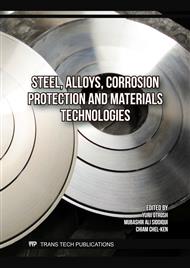[1]
A. Behera, A. K. Sahoo, and S. S. Mahapatra, 'Application of Ni-based superalloy in aero turbine blade: A review', Proceedings of the Institution of Mechanical Engineers, Part E: Journal of Process Mechanical Engineering, p.09544089231219104, Dec. 2023.
DOI: 10.1177/09544089231219104
Google Scholar
[2]
Z. Dere Yaman and S. Yalçinkaya, 'Engineering and Technology Management', 2021. [Online]. Available: https://www.researchgate.net/publication/ 358280101
Google Scholar
[3]
M. Kaur and K. Singh, 'Review on titanium and titanium based alloys as biomaterials for orthopaedic applications', Materials Science and Engineering: C, vol. 102, p.844–862, 2019.
DOI: 10.1016/j.msec.2019.04.064
Google Scholar
[4]
X. Liu, P. K. Chu, and C. Ding, 'Surface modification of titanium, titanium alloys, and related materials for biomedical applications', Materials Science and Engineering: R: Reports, vol. 47, no. 3, p.49–121, 2004.
DOI: 10.1016/j.mser.2004.11.001
Google Scholar
[5]
T. Shehbaz, M. Junaid, F. N. Khan, U. A. Akbar, and A. Saeed Hakeem, 'Dissimilar tungsten inert gas welding between Inconel 718 and commercially pure titanium using a vanadium interlayer', Proceedings of the Institution of Mechanical Engineers, Part L: Journal of Materials: Design and Applications, vol. 236, no. 4, p.715–729, Apr. 2022.
DOI: 10.1177/14644207211054265
Google Scholar
[6]
T. Shehbaz, F. N. Khan, M. Junaid, and J. Haider, 'Investigating nanoindentation creep behavior of pulsed-tig welded inconel 718 and commercially pure titanium using a vanadium interlayer', Metals (Basel), vol. 11, no. 9, Sep. 2021.
DOI: 10.3390/met11091492
Google Scholar
[7]
V. P. Singh, S. K. Patel, and B. Kuriachen, 'Mechanical and microstructural properties evolutions of various alloys welded through cooling assisted friction-stir welding: A review', Intermetallics (Barking), vol. 133, p.107122, 2021, doi: https://doi.org/10.1016/j.intermet. 2021.107122.
DOI: 10.1016/j.intermet.2021.107122
Google Scholar
[8]
J. C. Michel, H. Moulinec, and P. Suquet, 'Effective properties of composite materials with periodic microstructure: a computational approach', Comput Methods Appl Mech Eng, vol. 172, no. 1, p.109–143, 1999.
DOI: 10.1016/S0045-7825(98)00227-8
Google Scholar
[9]
J. Němeček, V. Králík, and J. Vondřejc, 'A two-scale micromechanical model for aluminium foam based on results from nanoindentation', Comput Struct, vol. 128, p.136–145, 2013.
DOI: 10.1016/j.compstruc.2013.07.007
Google Scholar
[10]
C. Ye, J. Chen, M. Xu, X. Wei, and H. Lu, 'Multi-scale simulation of nanoindentation on cast Inconel 718 and NbC precipitate for mechanical properties prediction', Materials Science and Engineering: A, vol. 662, p.385–394, Apr. 2016.
DOI: 10.1016/j.msea.2016.03.081
Google Scholar
[11]
L. Li, L. Shen, G. Proust, C. K. S. Moy, and G. Ranzi, 'Three-dimensional crystal plasticity finite element simulation of nanoindentation on aluminium alloy 2024', Materials Science and Engineering: A, vol. 579, p.41–49, 2013.
DOI: 10.1016/j.msea.2013.05.009
Google Scholar
[12]
M. Heidari, A. Karimzadeh, M. R. Ayatollahi, and M. Y. Yahya, 'Effects of particle distribution and calculation method on results of nano-indentation technique in heterogeneous nanocomposites-experimental and numerical approaches', Int J Solids Struct, vol. 225, Aug. 2021.
DOI: 10.1016/j.ijsolstr.2021.111054
Google Scholar
[13]
W. Sun et al., 'Nanoindentation creep behavior of nanocrystalline Ni and Ni-20 wt% Fe alloy and underlying mechanisms revealed by apparent activation volumes', Mater Des, vol. 225, p.111479, 2023.
DOI: 10.1016/j.matdes.2022.111479
Google Scholar
[14]
'The-geometrical-configuration-of-the-Berkovich-indenter-tip'.
Google Scholar
[15]
R. Firoz, S. K. Basantia, N. Khutia, H. N. Bar, S. Sivaprasad, and G. V. S. Murthy, 'Effect of microstructural constituents on mechanical properties and fracture toughness of Inconel 718 with anomalous deformation behavior at 650 °C', J Alloys Compd, vol. 845, p.156276, 2020.
DOI: 10.1016/j.jallcom.2020.156276
Google Scholar


